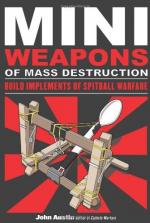|
This section contains 1,413 words (approx. 5 pages at 300 words per page) |

|
The phrase weapons of mass destruction (WMDs) was first used in the London Times in 1937 to describe Germany's blanket-bombing—using conventional weapons—of the city of Guernica, Spain (Mallon 2003). During the Cold War, the Soviet Union adapted the phrase to describe, collectively, nuclear, biological, and chemical (NBC) weapons (Norris and Fowler 1997). The U.S. Department of Defense defines WMDs as "weapons that are capable of a high order of destruction and/or being used in such a manner as to destroy large numbers of people," including high explosives, nuclear, chemical, biological, and radiological weapons. WMDs, however, often refer primarily to nuclear weapons.
History
Historical accounts of WMDs include the use of toxic smoke during the Peloponnesian War and during the Sung Dynasty in China (Hersh 1968); the Tartars catapulted plague-infected corpses into walled cities. Use of a scorched earth policy (Langford 2004) was also...
|
This section contains 1,413 words (approx. 5 pages at 300 words per page) |

|


